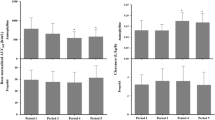Abstract
The plasma concentration vs. anesthetic effect relationships for ketamine are not well known. It is desirable to establish stable and predictable drug concentrations in plasma (and brain) in order to define such relationships. As a prelude to pharmacodynamic studies, we investigated ketamine pharmacokinetics in eight dogs anesthetized with enflurane and correlated ketamine concentration in plasma (KET) with its ability to reduce the enflurane concentration required for anesthesia (enflurane EC50: MAC-the endtidal concentration at which half the dogs moved in response to damping of the tail and half did not move). Four dogs (Group 1) received ketamine 10 mg/kg iv over 30 sec. Blood for determination of KET was collected repeatedly over the 5-h period following injection. Based on the pharmacokinetic parameters determined for Group I, four dogs in Group 2 received ketamine as a continuous infusion of 300 μg·kg−1·min−1 for 5hr accompanied by an initial loading dose (26 mg/kg administered over 20 min) designed to produce a stable KET of 20 μg/ml of plasma. Enflurane MAC and KET were determined regularly during the infusion and for 5 hr after discontinuation of the infusion. There were no significant differences in the following pharmacokinetic parameters determined for Group 1 vs. Group2:\(t_{\mathop 2\limits^ \bot \beta } \)=122±9 vs. 141±40min (\(\bar x\)±SD) and CL±8.1±5.9 vs. 13.9±2.5ml·kg−1min−1, respectively. When administered as a continuous infusion (Group 2), KET remained relatively stable at 22.1±4.6 μg/ml for 5hr. The degree of MAC reduction remained relatively stable at 73% during the continuous infusion. Finally, the enflurane MAC reduction vs. KET was established over a wide range of plasma concentrations in 4 additional dogs (Group 3). This study determined that the pharmacokinetics of ketamine were consistent under two different experimental conditions and demonstrated the relationship between plasma concentration and anesthetic effect in the dog.
Similar content being viewed by others
References
P. F. White, W. L. Way, and A. J. Trevor. Ketamine-Its pharmacology and therapeutic uses.Anesthesiology 56:119–136 (1982).
M. R. Murphy and C. C. Hug, Jr.. The anesthetic potency of fentanyl in terms of its reduction of enfluraneMAC.Anesthesiology 57:485–488 (1982).
J. G. Wagner. A safe method for rapidly achieving plasma concentration plateaus.Clin. Pharmacol. Ther. 16:691–700 (1974).
M. Gibaldi and D. Perrier.Pharmacokinetics, 2ed, Marcel Dekker, New York, 1982, pp. 45–111; 113–144; 409–417.
M. R. Murphy and C. C. Hug, Jr. Humaneness of anesthetic induction technique questioned (Letter to editor).Anesthesiology 59:260–261 (1983).
R. L. Stiller, J. A. Pajerski, P. G. Dayton, J. M. Perel, and C. C. Hug, Jr.. Gas chromatographic analysis of ketamine and norketamine in plasma and urine: Nitrogen-sensitive detection.J. Chromatog. 232:305–314 (1982).
Statistical Consultants, Inc. PCNONLIN and PCNONLIN 84: Software for the statistical analysis of nonlinear models.Am. Statist. 40:52 (1986).
H. G. Boxenbaum, S. Riegelman, and R. M. Elsahoff. Statistical estimations in pharmacokinetics.J. Pharmacokin. Biopharm. 2:123–148 (1974).
J. S. Kaka and W. L. Hayton. Pharmacokinetics of ketamine and two metabolites in the dog.J. Pharmacokin. Biopharm. 8:193–202 (1980).
L. Irestedt and M. Andreen. Effects of enflurane on hemodynamics and oxygen consumption in the dog with special reference to the liver and preportal tissues.Acta Anaesth. Scand. 23:13–26 (1979).
R. L. Hughes, D. Campbell, and W. Fitch. Effects of enflurane and halothane on liver blood flow and oxygen consumption in the greyhound.Br. J. Anaesth. 52:1079–1086 (1980).
S. S. Hanna. Measurement of liver blood flow by galactose clearance.Can. J. Surg. 27:218–220 (1984).
J. A. Clements and W. S. Nimmo. Pharmacokinetics and analgesic effect of ketamine in man.Br. J. Anaesth. 53:27–30 (1981).
J. Wieber, R. Gugler, J. H. Hengstmann, and H. J. Dengler. Pharmacokinetics of ketamine in man.Anaesthetist 24:260–263 (1975).
E. F. Domino, E. K. Zsigmond, L. E. Domino, K. E. Domino, S. P. Kothary, and S. E. Domino. Plasma levels of ketamine and two of its metabolites in surgical patients using a gas chromatographic mass fragmentographic assay.Anesth. Analg. 61:87–92 (1982).
Author information
Authors and Affiliations
Additional information
Supported in part by a grant from the Swiss National Fund.
Rights and permissions
About this article
Cite this article
Schwieger, I.M., Szlam, F. & Hug, C.C. The pharmacokinetics and pharmacodynamics of ketamine in dogs anesthetized with enflurane. Journal of Pharmacokinetics and Biopharmaceutics 19, 145–156 (1991). https://doi.org/10.1007/BF01073866
Received:
Revised:
Published:
Issue Date:
DOI: https://doi.org/10.1007/BF01073866




